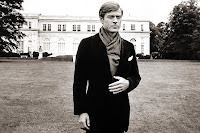
Cary Grant's head size was immense. Fred Astaire was the original thin man. John Wayne was somewhat barrel-chested, even as a lad. Elegant as they may have been, the physiques of these
Of course, legends such as Grant, Astaire and Wayne, among so many other stylish men of the silver screen, had the means to avail themselves of the finest custom tailors in
Hollywood and the movies led to enormous fashion directions that became American classics, including the two-button suit, the extended shoulder, high waist trousers (sometimes known as the “Hollywood” waistband), to name just a few. Perhaps even more importantly, it was the stylishly individual way these cinematic heroes put their clothes and looks together that is most noteworthy—Fred Astaire's and William Powell's impeccable double breasted suits with peaked lapels, always worn with pocket square and boutonniere deftly in place come immediately to mind. Or even James Dean's leather motorcycle jacket, worn with faded blue jeans and white T-shirt, a classic American combination if ever there was one.

Few in Hollywood could ever touch the personal style and consummate elegance of William Powell
In
Fast forward to the modern era. The British government may have given James Bond a license to kill, but Dormeuil, Savile Row, and later Brioni, gave the secret agent a license to thrill. Outfitting Pierce Brosnan in the recent 007 movies has been overwhelmingly valuable to both companies, not just because Brosnan looked exceedingly handsome in clothing custom tailored with Dormeuil cloth, but because the image of sartorial suave and sophistication long established as part of the fabled spy’s image, instantly rendered fine English tailoring chic.
Apart from James Bond’s wardrobe, Dormeuil over the years has supplied fine fabrics to the Savile Row tailors of many a screen idol, including such American stars as Ben Afflek, Tom Cruise, George Clooney, Al Pacino, Robert De Niro, Robert Wagner and Marlon Brando, to name just a few. In the film, Austin Powers, Michael Caine’s elegant, English cut suits were made from Dormeuil fabric.
What began with Sean Connery, developed later with Roger Moore and now is in the hands of Brosnan, is a virile, masculine character that is, in a manner of speaking, tailor made for stylish clothing. But as far back as the Forties, custom tailors such as those of Savile Row and Rome-based Brioni, among others, were much in demand for their impeccable tailoring that wealthy, elegant Americans would soon covet led by Hollywood icons as John Wayne, Clark Gable, Henry Fonda, Rock Hudson, Johnny Weismuller and Anthony Quinn.

Pierce Brosnan's own personal style was perfectly suited to his roles as debonair spy James Bond
Today, the look of custom tailoring is more in demand in the U.S. than it ever was, from the back lots of Hollywood and the front lawns of Palm Beach, to the oil-rich Texas ranches and bustling cities of New York, Chicago, Boston and Philadelphia.
To many fashion observers, Italian style was re-introduced to

Giorgio Armani's wardrobe design for Richard Gere in "American Gigolo" broke new fashion ground for men the world over
While "American Gigolo" may have been one of the first movies that enabled a fashion company to reap generous rewards from outfitting the man with the leading role, it certainly has not been the only one. American designer Ralph Lauren reaped huge rewards from his sartorial contribution to Robert Redford's title role in the film "The Great Gatsby." Likewise a few years later, American clothing designer and Anderson & Sheppard enthusiast Alan Flusser would win a lion’s share of accolades for the tailored clothing worn by Michael Douglas in the epic finance and corruption film, "Wall Street."
With the premier of “The Great Gatsby" came Lauren's most eloquent moment. As Robert Redford's remarkable wardrobe in the F. Scott Fitzgerald saga on screen attests, Lauren demonstrated just how rich and elegant men's clothing could be, emphasizing and underscoring the beauty in luxurious, classic and timeless clothing.
Gatsby’s perfectly fitted double-breasted suits, often with double-breasted waistcoats, Norfolk-inspired summer tweed jackets, pima cotton, colored spread-collar dress shirts, silk satin neckwear and cashmere surplice vests were impressive indeed. The clothes were nothing if not inspirational, especially to the younger generation of American designers who would follow in Lauren's footsteps.
In Wall Street, the Savile Row sensibility Flusser designed into the wardrobe for Gordon Gekko as portrayed by Douglas in the Oscar-winning film played an integral role in conveying the acrimonious financier’s arrogance and swagger, right down to the patterned braces, English spread-collar dress shirts and double barrel French cuffs. Few would argue the boost in sales that Flusser’s designs gave to the men’s tailored clothing business in general following the film’s success.
Likewise, Academy Award-winning costume designer Milena Canonero did such an outstanding job in designing the wardrobes for films such as "Chariots of Fire," "The Cotton Club" and "Out of Africa," that she parlayed her profound influence on men’s fashion in the early 80’s into a job with Norman Hilton Clothiers. A traditional American clothing manufacturer (now defunct), the Hilton company marketed a Milena Canonero Collection of hand-tailored suits, sportcoats, trousers and outerwear, all faithfully in keeping with the look of Thirties-inspired English country dressing so wonderfully showcased in “Chariots of Fire.”
The enormous success and popularity of “Chariots of Fire” occasioned renewed interest in fine tailored clothing and elegant fabrics, providing, in the process, an exciting new direction in men’s fashion. Credit was due the Italy-born Canonero, who artfully revived English style in all its cut, details and unsurpassed fabrications.
Given the current trends in fashion today, men’s wear designers would do well to once again turn to the silver screen for inspiration.


Great post, Ralph.
ReplyDeleteThank Jon!
ReplyDeleteNice
ReplyDelete